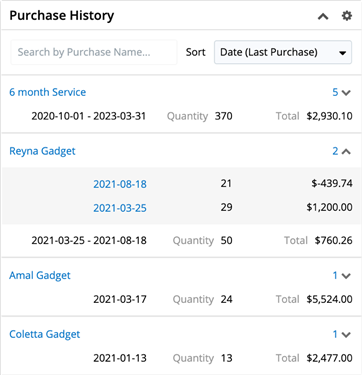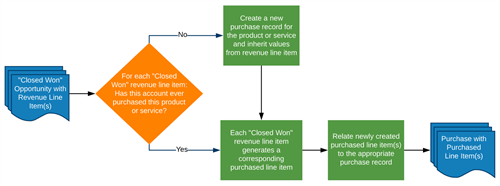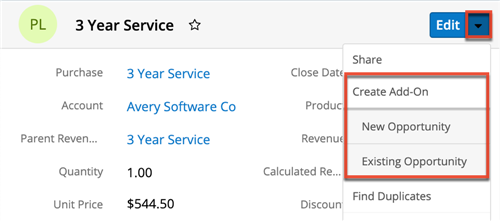Welcome to the second installment of our “Hidden Features” series for Sugar Sell & Sugar Enterprise. This ongoing series covers less commonly known features in Sugar Sell and Sugar Enterprise. If you have suggestions about a feature/capability we should showcase next, please reach out! We’d love to hear from you.
Purchase Tracking is a powerful feature within the Sugar platform. Read on to learn how you can use it for your business!
Purchase tracking helps you determine what customers bought from you, when they made purchases, and how much they paid. These are the foundations of understanding your business, analyzing your history, and optimizing your future. To facilitate purchase tracking within Sugar, we built the Purchases and Purchased Line Items modules.
The Purchases and Purchased Line Items modules act as a sync point for all your products and services sold. Additionally, these modules provide a single source of truth in the CRM, with one 360-degree, quick, “need to know” view of prospect revenue history. These modules can be integrated with other systems (e.g., ERPs), or Sugar admins can build configurations on top of them. The Purchases module shows the goods and services that have been sold to a customer, while purchased line items show each time something has been sold to a customer.
Let’s talk about how purchase tracking differs from Opportunities and Quotes in Sugar.
Opportunities have a specific job within the Sugar platform; they are the lifeblood of the sales process. Opportunities track a prospective sale from start to booking, and they are the basis of forecasting and seller compensation.
Quotes, too, have a job. They capture the nitty-gritty details of a proposal and allow sellers to quote deals with various scenarios to find the right fit for everyone. Once completed, quotes capture the agreed-upon pricing with details like tax, shipping, and terms.
But using either of these records as the source of truth for customer purchases is fraught with challenges. First, they contain both won and lost deals, both accepted and rejected proposals. When a customer is on the phone looking for support, time is of the essence. The last thing a rep wants to spend time on is sifting through these records to piece together a picture of what the customer has actually purchased. This scenario becomes even more troublesome with subsequent purchases like additional goods, extra license seats, returns, etc. The complete picture of what a customer has bought is then spread across multiple opportunities and quotes.
Adding to the complication, once a customer has been billed, other changes may occur in the CRM via integrations with other systems, such as ERP activity. Updating opportunities and quotes with these changes would come at the cost of the historical accuracy of the original booking.
Purchase tracking cuts out all of that noise to give a consolidated picture of a customer’s purchase history and current entitlements with down-to-the-cent accuracy.
Purchases are organized differently than opportunities; instead of being grouped by time, they are grouped by product. Every customer’s full purchase history is displayed as a journey, with every interaction, change, and outcome recorded and easily shareable across teams.

Think of each purchase record as a bucket, representing a single product or service purchased by an account. The purchased line item records that fill each bucket represent every time the account has purchased that product or service. Purchases and purchased line items can be created manually from within the modules, or if you use the Opportunities with Revenue Line Items model, records that are marked as “closed won” can automatically trigger the creation of these records, and admins can control when in the sales cycle they are generated.
Sugar sales and service users can access purchase tracking, while only sales users can access Opportunities and Quotes. This means that purchase tracking helps bridge the gap between typical selling motions and downstream operations, such as renewals, support, and order processing, by allowing users to easily manage goods/services sold, while also creating a dedicated space for the products or services that have reached the "Closed Won" stage of the sales cycle.

Purchase tracking also provides a dedicated place to sync ERP data. This allows for accuracy in spend tracking, without compromising the purpose and historical accuracy of opportunities and quotes. In this way, you can ensure that your data is always up-to-date and accurate across multiple systems.
Speaking of data accuracy, Sugar’s purchase tracking is built on a powerful, out-of-the-box, time-aware engine for increasing operational efficiency. While other CRMs are great at tracking the current state of sales opportunities, many stop at this single “present” point in time, providing only a snapshot of information. But CRM data constantly changes based on thousands of customer touchpoints and updates, resulting in missed opportunities for leveraging history or likely future outcomes. With Sugar, you can see the data that matters, such as customer spend over time or changes in customer buying that merit targeted action.
If your business sells duration-based services or subscriptions, purchase tracking provides an extra boost over time to help you better manage mid-term coterminous add-ons and cancelations.

For example, if you’re a software company, you may need to add additional licensed users for the remainder of the contracted service period without affecting the contracted end date. Purchase tracking provides the ability to easily add these types of products and services to existing purchased line items.
Additionally, if the service is renewable, Sugar supports the ability to automatically update the renewal opportunity and revenue line item related to the original purchase so that coterminous add-ons and the originally sold products/services are up for renewal simultaneously.
In this scenario, the term for the new service will incorporate a manually set start date, the existing end date, and a calculated duration. The pricing will default to a proration of the standard pricing. If the new deal includes more items than the original deal, it will default to a proration of the old deal’s pricing. In short, mid-term changes are automatically combined so that the renewal will always reflect what is currently available to renew at close of term.
While competitors make you do the calculations and the work, the Sugar platform does the work for you to support your renewals and subscription-based business. It’s one way we’re helping your team reduce clicks, busy work, and manual data entry.
How are you using Sugar’s purchase tracking capabilities in your business? Still have questions? Let us know by commenting below!